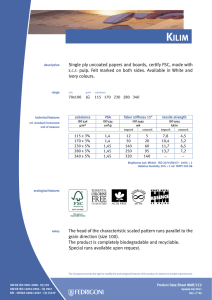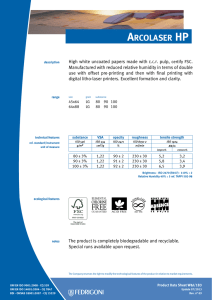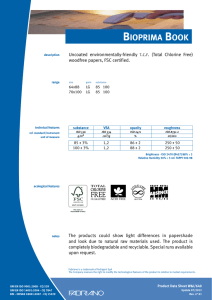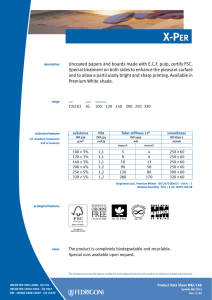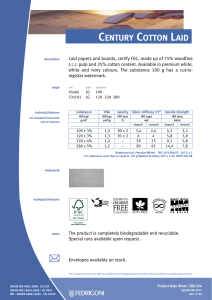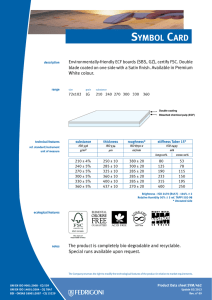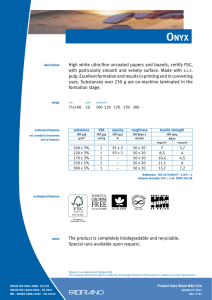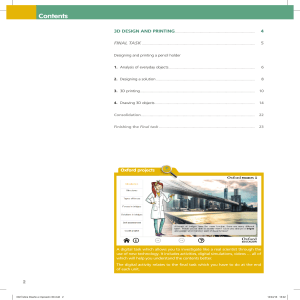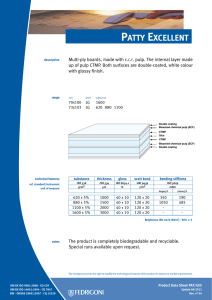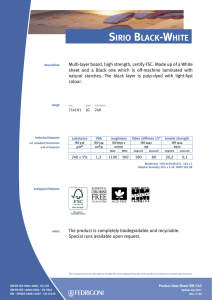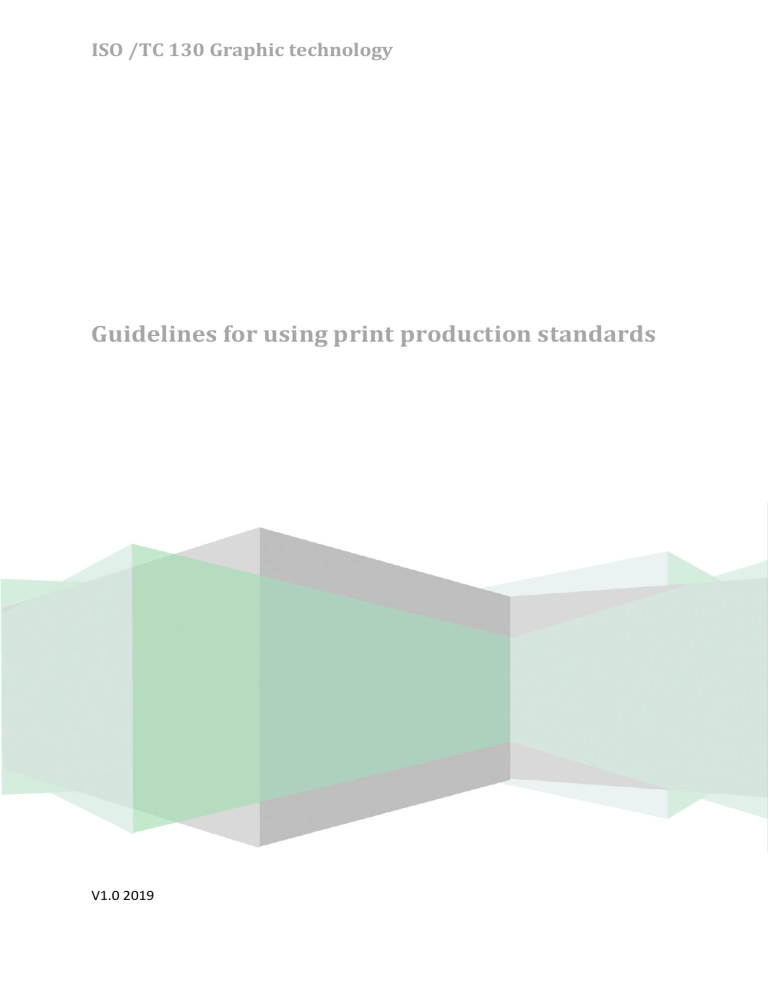
ISO /TC 130 Graphic technology Guidelines for using print production standards V1.0 2019 Contents Page Introduction ............................................................................................................................................................. 3 1 Scope ............................................................................................................................................................. 1 2 Terms and definitions.............................................................................................................................. 1 3 3.1 3.2 Graphic supply chain ................................................................................................................................ 1 Stakeholders, roles, and responsibilities ........................................................................................... 1 Use cases and product relationships ................................................................................................... 3 4 4.1 4.2 4.3 4.4 4.5 Base concepts ............................................................................................................................................. 4 Viewing conditions ................................................................................................................................... 4 Colour measurements.............................................................................................................................. 5 Printing condition ..................................................................................................................................... 5 Characterization ........................................................................................................................................ 5 Grey reproduction and grey balance ................................................................................................... 6 5 5.1 5.1.1 5.1.2 5.1.3 5.1.4 5.2 5.3 5.4 Workflows ................................................................................................................................................... 6 Design stage ................................................................................................................................................ 6 RGB images ................................................................................................................................................. 7 Process-dependent and process-independent design workflows............................................... 7 Preflighted press-ready files.................................................................................................................. 8 Proofing systems ....................................................................................................................................... 9 Prepress stage ......................................................................................................................................... 10 Printing stage .......................................................................................................................................... 12 Postpress stage ....................................................................................................................................... 13 6 Carbon footprint calculation............................................................................................................... 13 7 Interrelation of printing standards .................................................................................................. 13 Bibliography.......................................................................................................................................................... 15 iv Introduction Standards are documented consensus agreements containing safety, technical specifications, or other precise criteria to be used consistently as rules, guidelines, or definitions of characteristics for materials, products, processes, and services. In many cases, they provide uniformity, which allows worldwide acceptance and application of a product or material. The aim is to facilitate trade, exchange, and technology transfer. Standards help to remove technical barriers to trade leading to new markets and economic growth for the industry. Today, companies are facing fundamental changes in the way they do business. Strategies and business practices are continuously being evaluated to determine how to maintain and increase market share, reduce costs, increase productivity and safety, and achieve and maintain a competitive edge. Graphic arts companies face these changes starting from a point at which the standards are not completely adopted by the market even if they provide complete technical guidelines. Graphic industries are only a small part of the graphic market made up of micro and small handcraft companies throughout the world. During recent years, many transformations have occurred in the market. Digital communications and digital media technology have driven restructuring in the graphic arts industry. ISO/TC 130 is working to reflect these changes in the standard development structure with new approaches and ideas to follow today’s market and trends and anticipate future requirements. All graphic arts companies can use the structure of the published standards to support their business and to harmonize production workflows irrespective of the size of the company. Published standards for the printing, publishing, and finishing industries enable processes to run faster, more predictably and more efficiently, and to be more cost effective by — providing uniform, defined procedures, and tools that help users produce quality products for their customers, — facilitating interconnectivity and process integration among systems, — allowing users to communicate easily with one another, — enhancing product quality and reliability at a reasonable price, — increasing distribution efficiency and ease of maintenance, — improving health, safety, and environmental protection, and — reducing waste. The language used to write standards in recent decades mainly reflects the needs of printers and the printers’ suppliers, ignoring the other actors in the printing supply chain. This document tries to describe the relationship between standards with all the actors in the graphic supply chain taken into account, preparing the market for tomorrow’s standards structure. The composition of the graphic arts supply chain varies depending on the kind of product manufactured and the size of the graphics project measured in terms of the number of copies, but tends to be similar around the world. Every actor or stakeholder in the supply chain may be a single person, a small company, or a big organization. In every case, thanks to the digitalization of the graphic arts supply chain achieved mainly over the past 20 years, instruments, methodology, and production standards can be the same irrespective of the size of the stakeholder’s organization. Today, a single freelance designer can use the same software and provide the same results as a gigantic multi-national agency and there is no technical reason why they should not use the same standards. The same is true for printers. A small printing company with the ability to produce at the same quality level can compete or collaborate with big companies if both follow the ISO standards. . iii All the ISO/TC 130 standards, particularly the process control standards, aim to describe the so-called “standard quality”. Many people in the graphic arts industry think that this “standard quality” is good for big production companies distributed worldwide, but not for small regional production companies. This was not the intention of ISO/TC 130 because if the “standard quality” reflects the minimum set of warranties that a supplier needs to give to customers, in terms of fulfilling the expectation of a small variability within printing runs, most of the companies that ignore ISO standards have big problems in maintaining a constant level of predictable quality of the final results. Without such predictability, the result is likely to change in every printing run and the final product will be a unique handcrafted printed product, which in most cases, is unlikely to fulfil the needs of customers in any scenario. The set of parameters used to define the print quality attributes of a final graphic product have not been described in any document up to now, but ISO/TC 130 is working with other ISO committees to define such a set. ISO/TC 130 standards describe and define certain parameters for a printing product, together with their tolerances, but ignore most of them. Since most ISO standards are related to properties of materials and to process control, the quality is here defined by parameters related to single and unfinished print. Within ISO aims and tolerances, there is the possibility of delivering different products so that small companies making regional products can benefit from standardization and produce something both unique and precious. At the same time, big companies can follow ISO aims and tolerances strictly to guarantee predictability and consistency around the world. Quality control of the final product is not, in most cases, standardized so finishing processes such as lamination, varnishes, and binding, which affect customer satisfaction, will depend on the ability of printers, finishers, or converters. Digital printing is more and more widely used in graphic arts production and its processes interrelate and overlap with traditional printing. There are many different fast-changing digital printing technologies and it is now included in many conventional printing companies. We can consider a printing process as digital either when the image is transferred to the substrate by a digital technology and there is no printing form or when the process has the ability to change the image with every print. Digital printing influences workflows and process control. International Standards that support digital printing are under development within ISO/TC 130, for instance, the ISO 15311 (all parts). Other ISO documents can be used in a digital printing workflow, for instance, the ISO PAS 15339 (all parts). Note: This document was originally published as a Technical Report, but was later made into a document free to download at no cost. iv Guidelines for using print production standards 1. Scope This Technical Report provides guidelines to enable print industry stakeholders to use ISO/TC 130 and related standards in print media production workflows. The use of these standards is intended to enhance production quality, business performance, profitability, and sustainability. 2. Terms and definitions For the purposes of this document, the following terms and definitions apply. International Colour Consortium profile ICC profile collection of transforms, encoded as specified in the ICC profile specification which is used to convert image data between device space and profile connection space preflighted press-ready file prepress file which contains all technical elements required by printing and postpress processes defined for the production, verified by a preflight software proof hard or soft copy reproduction made using various technologies to simulate an intended printing output use case category that combines graphic products that have been developed for the same marketing purpose validation print print produced directly from digital data early in the production chain, meeting the requirements of ISO 12647-8 representative of the concept for the final product stakeholder any person or organization that is involved in graphic supply chain or can give inputs for print process 3. Graphic supply chain Stakeholders, roles, and responsibilities A complete and coherent description of the graphic supply chain, as referenced by ISO/TC 130 standards, is not explicitly declared in any document. Depending on the use case and the product concerned, stakeholders may play different roles and share different responsibilities as stated in Table 1. Table 1 — Description of stakeholders, roles, and responsibilities Stakeholder Description, roles, responsibilities Print buyer The purchaser of a single graphical product or of some coordinated graphical products. Their role may include the following: — communicate the customer expectation to all relevant stakeholders; — contracts to confirm technical specifications compatible with printing production standards; — approval of validation prints and proofs; 1 — approval of OK sheets or OK samples; — approval of the print run; — approval of the finished job. Has the responsibility to communicate the specifics of graphic design in a manner consistent with relevant standards. Designer A person who plans the appearance and/or structure of a graphic project prior to it being produced. Their role is not covered in existing ISO/TC 130 standards. Prepress company/ operator A person or organization that enables the printing of a generic graphic project using a specific printing process. Their role may include the following: — digital file conversion; — content adaption; — composition, page layout; — colour transformations; — generation of a digital reference file; — production of printing forms. Has the responsibility to follow pertinent ISO/TC 130 standards during any transformation, including the following:. — assurance of data integrity; — providing the correct preflighted press-ready data or the correct printing forms to the printer; — responsibility for communication between stakeholders if there are any technical problems between the graphic project being received from designer and technical information about the printing process being received by the printer. Printer company/ operator A person or an organization that prints the job using a specific printing process. Their role may include the following: — communication to the prepress operator of the technical details of the printing process; — printing the job according to the technical specification of the print run; — delivery of the job to the next process responsible. Has the responsibility either to follow ISO/TC 130 standards relating to the printing process or to follow other agreements between the parties. In every case, it has the following responsibilities: — use printing substrates and inks compatible with ISO/TC 130 standards or with agreement between parties, any process compatible substrates, and inks; — communicate to the prepress operator and/or designer and/or print buyer about any visual differences between the proofs provided and the current print run; — ensure that process variability is under control and within the tolerances specified in the appropriate ISO/TC 130 standards. A printing quality management system is recommended. Postpress company/ operator A person or an organization that takes the final communication step which allows full exchange of the specification of the printing product receiving printing material to be finished, assembled, bound, or converted. Their role may include the following: — communication to the prepress operator about technical details of the required operations in order to ensure creation of the correct digital data or forms; — carrying out the requested finishing, converting, assembly, and binding operations; — delivery of the final product. In addition, the operator — has the responsibility either to follow ISO/TC 130 standards relating to any postpress 2 operation process or to comply with any other agreements between parties, — has the responsibility to communicate to the printer and/or the prepress operator and/or the print buyer about any defects in received or processed materials, and — ensure that process variability is under control and within the tolerance specified by appropriate ISO/TC 130 standards. A quality management system is recommended. 4. Use cases and product relationships The boundaries between different printing processes are becoming very blurred because of new technologies and innovations. However, Table 2 shows a possible example of categorization of print products as seen from a print buyer’s side that links final product and process used to print. Table 2 — Possible example of categorization of print products organized by use cases Category Use case Sub case Example of product Typical printing processa Monthly magazine Gravure or offset Offset Magazines Weekly magazine Commercial production printing Publishing Picture/photo book Offset Comic, paperback, textbook, directory Offset Magazine cover Monthly/weekly magazine (cover) Offset Catalogue Catalogue of product or services Offset or Gravure Flyer, pamphlet, leaflet Offset or Gravure Direct marketing Offset Free magazine Offset Others Manual Offset Business form Slip, Carbon copy Offset Transaction Transaction for cellphone Offset Stationery Notebook, envelope business card, postcard Offset Letterpress Card Magnetic stripe card, IC card Offset screen Monograph Commercial Commercial production printing Business form and card Offset Letterpress Advertisement 3 Newspaper Colour, B/W, tabloid Daily newspaper Web offset (cold set) Poster Poster Inkjet Offset POP-up Banner, tapestry, textile Inkjet offset screen Billboard Billboard Inkjet screen Wrapping decoration Wrapping decoration, bus Inkjet screen Carton Beverage carton, cardboard container, box Offset Corrugated Corrugated box Offset flexo Label Label Sticker Flexo Flexible Snack pouch, retort pouch Gravure flexo Indoor use Signage printing Outdoor use Packaging (carton, label) Packaging Flexible packaging a Digital technology is not stated because it could be used in every production shown in the table. 4. Base concepts ISO standards for graphic arts and the related workflows described in this Clause imply some basic concepts that have significantly evolved over the recent years. The intended audience for these concepts, as described in the actual ISO standards, is mainly technical. The summary provided would be an index of arguments and references. Viewing conditions While colour measurements play an important role in the control of colour reproduction, they cannot replace the human observer for final assessment of the quality of complex images. Paper and other substrates contribute to the perceived colours and controlling these is equally critical. ISO 3664:2009 contains all the necessary specifications and information about viewing conditions for critical and practical comparison of printed samples such as reference illuminant, illuminance level, colour rendering index, and other parameters that should be used by all stakeholders to assess the lighting environment of working places. An important update in ISO 3664:2009 includes a better specification of the light in the ultraviolet (UV) and visible spectrum range to avoid distorting the appearance of samples in comparison with the appearance under commonly used sources of illumination such as daylight. The UV content is important where fluorescent samples are encountered, a phenomenon associated with many of the paper substrates on which images are reproduced as well as with some of the dyes and pigments themselves. The new measurement conditions described in 3.2 are defined with reference to this aim and specify tolerances that provide consistency between visual judgment and colour measurement. 4 Colour measurements To assess the quality of a coloured printed product and to control the process, all the standards refer to colour aims and tolerances. It is not expected that measured colorimetric data will provide an absolute correlation with visual colour appearance, although recent improvements in lighting equipment and measurement instrument technology provide stakeholders with a good level of correlation if all the standards are applied. ISO 13655:2009 contains all the necessary specifications for spectral measurements and colorimetric computation, and even if these are intended for use by instrument and systems suppliers, it is very important that the base concepts are clear to all stakeholders so as to achieve conformity in the equipment and methods used. The four measurement conditions (M0, M1, M2, and M3) may provide different spectral values and colorimetric interpretations (CIELAB) for the same sample depending on the degree to which they fluoresce. It is very important that the stakeholders agree on which kind of condition is to be used to exchange data, adding information about the backing that can be extrapolated from process standards. Condition M0 refers to all spectrophotometers or densitometers compliant with old versions of ISO 13655 or optimized with density measurements according to ISO 5-3. If there is a lack of information about colour measurements, M0 should be assumed. Condition M1 defines UV content more accurately and makes it possible to minimize variations in measurement results between instruments due to fluorescence (arising from optical brighteners in the substrate and/or fluorescence of the printing and/or proofing colorants). Condition M1 also improves the consistency between measurement results and visual assessment in viewing booths that meets the requirements of ISO 3664:2009. Condition M2 was previously called “UV-cut” and is adopted when the fluorescence needs to be excluded from the measurements. The effect is that there is poor consistency with visual assessment. However, M2 is still used to make characterizations in some digital printing environments where proofing is not commonly used. Condition M3 refers to polarized densitometers which are used for process control, especially in sheetfed offset printing. Even if it is possible to manage spectral or colorimetric M3 data, there is no practical application in any process standard. Printing condition A printing condition is defined by a set of primary process parameters that have a direct bearing on the visual appearance of a printed product. For every printing process, specific parameters are defined that contribute to summarizing the printing condition as described in the appropriate part of ISO 12647. These parameters include, for example, the colour and gloss of the paper substrate, the colour of the process inks, the screening adopted, and the curves specifying the tonal value increase. A complete explanation of the printing condition can be found in ISO 12647-1. Characterization When a printing condition is established through a process standard, it is then possible to measure a colour characterization that describes the colour reproduction capability of the process, including the colour of the substrate and the description of the colour gamut. Characterization data comprise a set of tone values and associated colorimetric values that fully describe a given printing process. Where such a set of colour characterization data are used as a reference in workflows, it is referred to as a characterized reference printing condition (CRPC) as described in the ISO PAS 15339 (all parts) documents. 5 Depending on the chosen workflow, to ensure the consistency of colour reproduction from the design stage to the print stage, it is very important for digital artwork that correct communication of the characterization is ensured. A characterization may be referred to by a commonly used name maintained by an association or organization (e.g. FOGRA39 or GRACoL_2006) and either the colorimetric files exchanged as defined in ISO 12642 or ICC output profiles exchanged as defined in ISO 15076-1. Grey reproduction and grey balance Reproduction of neutral grey colours is an important topic in every CMYK printing process because it affects the overall visual appearance of the printed product and facilitates process control. A neutral grey colour composed of specific CMY tone values is one of the most difficult colours to reproduce in a printing system. This is due to many technical reasons and to the high sensitivity of human vision when viewing neutral shades. For these reasons, grey reproduction is used by all stakeholders to check and control every reproduction device in the workflow. A complete definition of grey reproduction and grey balance can be found in ISO 12647-2 and, even though it relates in that part of ISO 12647 to offset printing process, it also applies to all other processes. The evaluation of grey reproduction by visual judgment or by measurement in the presence of fluorescent substrates is critical and, to avoid distortion, it is important that the requirements of ISO 3664 and ISO 13655 should be strictly adhered to as described in 4.1 and 4.2. 5. Workflows Many workflows can be compatible with graphic arts International Standards depending on the use case or product defined in Clause 2. This Technical Report recognizes and makes suggestions for the stages described in Table 3. Table 3 — Inputs and outputs of workflow stages Workflow stage Input Output Design Raw text, data, graphics, images Preflighted press-ready files Prepress Preflighted press-ready files Printing forms Printing Printing forms Unfinished printing material Postpress Unfinished printed material Final communication project Design stage The design stage is only partially covered by ISO/TC 130 International Standards as the first stage of the printing workflow. This lack of standardization can cause a waste of time in the following stages with negative economic impact. There are some International Standards that can be used in the design stage to ensure better consistency with the rest of the workflow: — when assessing images, proofs, and prints, viewing booths should comply with ISO 3664; — for soft proofing, ISO 14861 along with ISO 12646 should be used; — for contract proofs, typically produced using high-end inkjet printers, ISO 12647-7 should be used; — for intermediate proofs often using laser or desktop inkjet printers, ISO 12647-8 (for validation prints) should be used; 6 — artwork should preferably be delivered as PDF/X compliant to ISO 15930-7 or later. Preflight should be performed prior to submission. RGB images When images are prepared, it is important to be able to communicate the appearance intended by the creator of the image in a way that can be clearly understood by all stakeholders in the printing supply chain. ISO 16760 provides a framework to enable clear communication by defining how to make reference RGB images, including extensions to file formats and how to communicate image metadata (printing conditions and approval status) and requirements for RGB reference prints that can be used to show all actors the expected printed result. When RGB reference images are created, it is important to do this in a carefully controlled environment to ensure that the image viewed is representative of the image that will finally be printed. Guidance is provided in ISO 16760 for a suitable iterative procedure that includes the steps of — preparing a candidate RGB reference image, — creating an RGB reference print, — viewing the RGB reference print, and — assessing the RGB reference print and adding approval status. In order to provide a reference that can be used easily by all stakeholders in the print supply chain, requirements for an RGB reference printer and for RGB reference prints are provided. The RGB reference image is printed on the RGB reference printer with the printer calibrated to the intended printing condition. In this way, the printed reference image accurately reflects the result that will be produced when the image is finally printed. Process-dependent and process-independent design workflows The main goal of a printing standardized workflow is to fulfil customer expectations, providing a preview of the final results before the printing run, as early as possible in the process, and to provide the desired final result. This is possible if preflighted press-ready files related to the specific process are prepared as described in 5.1.3. This is the usual approach as described in the ISO 12647 (all parts) and used in the industry. However, there are times when the process used to print a specific job is not well defined from the beginning or is completely unknown. Label printing can be considered as an example. A label may be printed by the lithographic offset process, by the flexographic process, or by digital printing depending on the run-length requirements and the substrates to be used. In this case, a new process-independent design approach is described in ISO PAS 15339 (all parts). Depending on workflow agreed between design, prepress, and printing stakeholders either a process-related approach based only on ISO 12647 or a process-independent approach based on ISO PAS 15339 (all parts) for early stages and ISO 12647 for printing control can be chosen, as shown in Table 4. Both methods are compatible with standards and allow the achievement of the goal. Table 4 — Process-dependent vs. process-independent workflows Method for design Process dependent Standards for design and prepress stage ISO 12647-2, ISO 12647-3, ISO 12647-4, ISO 12647-5, ISO 12647-6 Characterization data for design and proofing purposes Process-dependent provided by organizations (for example, FOGRA39 or GRACol2006_Coated1v2 for offset printing) Printing process control Process-related part of ISO 12647 7 Process independent ISO PAS 15339-1 Set of CRPC (characterized reference printing conditions) as described in ISO PAS 15339-2 Process-related part of ISO 12647 It should be noted that process-dependent and process-independent workflows are rather different from the so-called “early binding” and “late binding” colour management methods. Please refer to the pertinent parts of ISO 12647 (all parts) and ISO PAS 15339 for a complete explanation. Preflighted press-ready files Most process control standards define the requirements for preflighted press-ready files, to be used in process-dependent design workflows. A summary of requirements is shown in Table 5. Table 5 — Requirements for preflighted press-ready files Process Standard Requirements Recommendations Offset lithography ISO 12647-2:2013 PDF/X data format. Delivery of a digital proof print or a print proof or an OK print from a previous run. Coldset offset lithography on newsprint ISO 12647-3:2013 CMYK, RGB, or CIELAB colour format. Printing condition indicated as a description, characterization data set, or ICC output profile. In case of RGB, ICC input profile. In case of RGB or CIELAB, rendering intent. Publication gravure printing ISO 12647-4:2014 CMYK or printing-channel-related colour format. A printing condition such as ICC registry name, characterization data, or ICC profile. Resolution of continuous tone data ≥120 cm−1. Line works data three to six times the resolution of continuous tone data. If a proof print is provided, it needs to refer to the output printing condition. PDF/X or TIFF/IT data format. Deliver of a proof print. If text data are provided as continuous tone data, it needs to be anti-aliased. Screen printing ISO 12647-5:2015 Film Flexographic printing ISO 12647-6:2012 Film, digital data, or printing forms. In the case of film or forms, distortion needs to be agreed between parts. In the case of digital files, PDF/X data format with CMYK, CMYK plus spot colours or CMYK with replacement colours, with printing condition defined. Delivery of a digital print proof. PDF/X data format. Delivery of a digital proof print or an OK print from a previous run. Adherence to these parameters enables prepress operators and/or printing companies to use ISO process control standards. The use of PDF/X file format, even if not mandatory in all processes, is strictly recommended in order to simplify the exchange of the data between companies and to reduce the technical errors and the misinterpretation of the desired data. 8 Some printing process standards allow the delivery of colour data that has not been prepared for the intended printing condition. In such a case, during the prepress stage, a conversion of the data needs to be performed in order to achieve the desired result. Sometimes, this conversion is critical and affects the quality of the final result for parameters other than the colours (e.g. a black-screened dot in a light area). For this reason, the delivery of data prepared for the intended printing condition is the most secured path and leads to predictable results. The safest path in this case is to move to a processindependent design workflow as described in 5.1.2. There also are other techniques of prepress process described in 5.2. Although the delivery of RGB preflighted press-ready files seems to be an easy task provided by modern software and workflows, there is a lack of common practice and standards on the market regarding the predictability of the result. Workflows based on PDF/X-3 or PDF/X-4 data with mixed colour information (RGB, CMYK, …) can be suggested only inside a single organization after specific tests have been carried out on the device involved in the workflow. Please refer to the ISO 15930 (all parts), especially ISO 15930-4:2003 about PDF/X-1a, for a complete description of CMYK and spot-colour data exchange and to ISO 15930-7:2010 for RGB, CMYK, spotcolour, and other data exchange. Proofing systems Digital print proofs have been introduced quite recently to the design market and most are calibrated with reference to a standard printing offset condition on coated paper (for instance, ISO 12647-2, FOGRA39, ISOCoated v2 or CGATS TR006, GRACol2006_Coated1v2). This kind of proof can predict the final result only if the printing process is calibrated according to the aforementioned printing condition or if, during the prepress stage, some adjustment of the data is performed. If the actual printing conditions are very different from the aforementioned printing conditions, because of the process, the paper, the inks, or whatever else, the provided digital proof cannot represent a preview of the printed result. For this reason, the delivery of digital proofs calibrated according to output printing conditions is highly recommended. ISO 12647-7 specifies requirements for systems that are used to produce hardcopy digital proof prints intended to simulate a printing condition defined by a set of characterization data and it contains recommendations with regard to appropriate test methods associated with these requirements. The ISO 12647-7 digital proofs are usually referred to as “contract proofs”. They are used as part of the contractual relationship between customer and printer and are used as a visual aim for the press operator during printing as well as an absolute reference against which the finished product is compared. During the design stage, when there is a need for a visual representation of the document to be printed, but without the quality of a “contract proof”, the intermediate quality level is called a “validation print” and is standardized according to ISO 12647-8:2012. Even if ISO 12647-7 contract proofs are usually made on an inkjet proofing system and ISO 12647-8 validation prints are made on a laser printer, there is no restriction on the technology a company can use to produce these proofs. Another important aspect is that both standards leave the company free to select the simulated characterization data or ICC profile which may be, for example, FOGRA39 or GRACol2006_Coated1v2 or other process-related data. The standards are focused more on tolerance and quality of reproduction. In both cases, if digital printers are used, it is very important that the complete proofing or validation system (a combination of digital printer, inks, proofing paper, proofing software) conforms to relative standard. Organizations provide ISO 12647-7 or ISO 12647-8 certifications that are valid only under the provided configuration of the system. Using proofs or validation prints that do not meet ISO 12647-7 or at least ISO 12647-8 standards, and without agreement on the intended simulated printing condition, may introduce a potential misrepresentation of the visual appearance of the intended printed product, causing a lack of predictability of the final result, thus with negative economic and quality impacts. The use of images displayed on a colour monitor is increasingly being used in the graphic arts industry for colour evaluation and colour acceptance (commonly referred to as “soft” proofing). This requires 9 that the colour display and its associated viewing environment be able to simulate the appearance of the final printed image viewed under standard graphic arts viewing conditions. The major components required to accomplish this are assembled to create a soft proofing system which is usually comprised of a monitor, colour measurement device, driver software (for calibration, profiling the monitor, and displaying the data), and a viewing cabinet. Three common soft-proof scenarios are typically encountered. In the first scenario, a soft proof is displayed on a monitor without an associated viewing cabinet. In the second scenario, a viewing cabinet is associated with the monitor. In the third, the monitor is a part of, and built into, a viewing cabinet. The use of a stand-alone display in uncontrolled ambient lighting is not covered in the standardized soft proof scenario because the final visual appearance of a soft proof on a display may not be judged without taking into account the influence of the ambient light even when the soft proof is viewed alone without comparison to a physical object such as a proof print, production print, or product sample. ISO 14861 contains all the necessary information about requirements for colour soft proofing and is strictly related to ISO 12646 about the characteristics of displays for colour proofing and to ISO 3664:2009 about viewing conditions. Prepress stage The prepress stage is strictly related to the final printing process since, starting from data reception from design agencies, it must ensure the creation of a printing form that, printed under a specific condition, produces the desired result. In most printing processes, the creation of general-purpose printing forms (e.g. a printing plate to be used on a generic offset press) is overcome by the sophistication of the technology so that the usual scenario is to produce forms from digital files prepared for a specific printing machine or condition. The adoption of this approach is very important, meaning that at the prepress stage, the exact printing machine or condition should be known before the right forms are prepared. There are many ways to achieve this goal depending on the final printing process and on whether the workflow is process dependent or process independent as described in 5.1.2. Moreover, during the prepress stage, it is sometimes necessary to ensure consistency between different printing presses that share the same process and general aim conditions while sometimes, the required consistency is between different printing processes. One of the critical points is adjusting the colour reproduction of a printing system to match a provided set of characterization data. ISO/TS 10128:2009 describes three methods for the adjustment of the digital content data that is input to a printing system to achieve consistency in the printed results on a number of presses that are printing to the same general aim conditions. These three methods are generally identified as matching of tone value curves, use of near-neutral scales, and use of CMYK to CMYK multi-dimensional transforms. a) Matching of tone value curves In some situations, a printing system can be adjusted to match a reference by adjusting the tone value increase, but only if the primary (C, M, Y, K) and secondary (C+M, C+Y, M+Y) colour solids match and the paper and inks comply with the specification of the printing standard being matched. The adjustment of the tone value increase curves (previously called “dot gain”) can be done on digital data or during the production of the printing form. This kind of match ensures consistency in process control and, generally, good enough tolerances for generic commercial products. However, it is not enough to ensure the matching of provided characterization data in critical jobs when the print needs to reproduce the desired colours with a high level of accuracy. b) Use of near-neutral scales 10 An alternative method is to adjust the tonal value increase curves matching a desired grey balance condition extracted from the characterization data. ISO 12647-2:2013, Annex A provides clear information about grey reproduction and grey scale which could be used in every printing process. This kind of match ensures the same level of compliance as method a). c) Use of CMYK-to-CMYK multi-dimensional transforms (such as ICC device-link colour management profiles) Most sophisticated approaches provided by software vendors use this kind of transform to adjust every single CMYK colour combination to match the desired characterization data. The approach is not classic colour management (such as using ICC profiles) because it keeps the relationship between black (K) and other primary colours (C, M, Y), and/or maintains other aspects of the original colour value which are important for their printability. There are several software tools available on the market that allow operations such as “repurposing” or “retargeting” which rely on methods described in item a) to c). Although there are multiple scenarios, they can be summarized in Table 6. 11 Table 6 — Possible scenarios for file adjustment to match printing processes Process-dependent data prepared for the intended printing condition Process-independent data or process-dependent data not prepared for the current printing condition Single printing process and press. No adjustment needed or finetuning using method a) or method b) of ISO/TS 10128. Method c) of ISO/TS 10128, sometimes preceded by ICC profile transform. Single printing process, but multiple press sharing the same printing condition. No adjustment needed or finetuning using method a) or method b) of ISO/TS 10128 to match the printing condition. It is possible to use the aforementioned methods for every press with an understanding that this may introduce additional complexity in the prepress workflow. Method c) of ISO/TS 10128 to match the printing condition, sometimes preceded by ICC profile transform. It is possible to use the aforementioned methods for every press with an understanding this may introduce additional complexity in the prepress workflow. Different printing processes or multiple press not sharing the same printing condition. On presses that conform to the intended printing condition, adjustment needed or finetuning using method a) or b) of ISO/TS 10128. On other presses, act as if the data are independent of the process, taking care about limitations due to specific issues (e.g. burn of light shades on flexographic printing, which cannot be automatically reconstructed for offset printing). Method c) of ISO/TS 10128 repeated for every printing condition, sometimes preceded by ICC profile transform. Printing stage The printing stage is the stage that is most completely covered by International Standards with the ISO 12647 (all parts). These standards relate to most traditional printing processes and they contain specifications or indications for process control aim values and tolerances. The aim values provided include screening parameters, inks, and substrate which are valid under some precondition. As noted in 5.2, conforming to process control aim values does not guarantee the colour matching between the printing results and the provided proofs and/or characterization data. To achieve the desired result and fulfil customer expectations, the following steps should be taken: a) control the viewing and colour measurement conditions as described in 4.1 and 4.2; b) ensures that the parameters of the intended printing condition are satisfied (e.g. substrate/paper type and colour, ink compliance); c) match the process control aim values under the provided tolerances as described in the pertinent part of ISO 12647; d) match the desired characterization data using the methods described in 5.2 following a tolerance schema provided by an organization such as IDEAlliance or FOGRA or following ISO PAS 15339-1 Annex B. As can be seen from the list above, the printing results are strictly dependent on the prepress stage and on the agreement of conditions between the pressroom and prepress operations. 12 Postpress stage The postpress stage involves the final communication step which completes the full exchange of the printing product specification. The ability to specify postpress requirements will explicitly reduce the occurrence of remakes resulting from inadequate specification of finished product requirements and lessen the impact on the environment of scrap products. The series of postpress International Standards will define the interface between the product printed and the assembly of the printed product into finished goods (books, magazines, newspapers, pamphlets, and packaging products, etc.) and contain requirements for operation and test procedures to be used to accomplish these operations. Though some surface finishing operations such as coating, laminating, etc., can affect the colour appearance of the finished product, this series of International Standards will not consider surface decoration, although the effects on the colour are discussed for the pertinent printing process in International Standards such as ISO 12647 (all parts). ISO 16762 will be the umbrella International Standard for postpress processes within the graphic arts industry. Many postpress processes are comprised of multiple components which are assembled together or combined. This International Standard will describe how these components are presented and measured to enable downstream processes to be carried out correctly, irrespective of the finishing process. ISO 16763 will provide the necessary guidelines to enable the people involved in each phase of the production process (prepress, printing, and postpress) to understand the implications of each successive phase as it impacts postpress, thus providing a quality product. This International Standard will specify process parameters and tolerances, material requirements, and binding quality checks to be applied to bound products. This International Standard will be directly applicable to products requiring industrial binding (e.g. books, magazines, catalogues, and brochures). It applies neither to packaging products and surface finishing, which will be covered by other International Standards, nor to craft binding. 6. Carbon footprint calculation ISO 16759 is a framework methodology for carbon calculators and provides a benchmark for carbon calculator quality control. It helps the print customer to calculate their contribution to national and international CO2e reduction targets via government schemes or through industry associations. Use of ISO 16759 facilitates the comparison of the carbon footprint of cross media content and media products delivered digitally, for instance, to websites, in emails, on DVDs, mobile devices, and so on. 7. Interrelation of printing standards Although each ISO standard is independent of the others, the workflows described in Figure 1 show an interrelation between printing standards. The direction of the arrows indicates referenced documents, for example, ISO 12647-2 references ISO/TS 10128. 13 Figure 1 — Example of interrelation of relevant standards for offset printing 14 Bibliography Workflow-relevant standard [1] ISO 12647 (all parts), Graphic technology — Process control for the manufacture of half-tone colour separations, proof and production prints [2] ISO 16759:2013, Graphic technology — Quantification and communication for calculating the carbon footprint of print media products [3] ISO 16760:2014, Graphic technology — Prepress data exchange — Preparation and visualization of RGB images to be used in RGB-based graphics arts workflows [4] ISO 16763, Graphic technology — Requirements for postpress — Bound products [5] ISO/TS 10128, Graphic technology — Methods of adjustment of the colour reproduction of a printing system to match a set of characterization data [6] ISO/PAS 15339 (all parts), Graphic technology — Printing from digital data across multiple technologies [7] ISO 16762, Graphic technology — Postpress — General Requirements Technical key standard [8] ISO 5-3:2009, Photography and graphic technology — Density measurements — Part 3: Spectral conditions [9] ISO 2846 (all parts), Graphic technology — Colour and transparency of printing ink sets for fourcolour printing [10] ISO 3664, Graphic technology and photography — Viewing conditions [11] ISO 12642 (all parts), Graphic technology — Input data for characterization of four-colour process printing [12] ISO 12646, Graphic technology — Displays for colour proofing — Characteristics and viewing conditions [13] ISO 13655, Graphic technology — Spectral measurement and colorimetric computation for graphic arts images [14] ISO 14861, Graphic technology — Requirements for colour soft proofing systems [15] ISO 15076-1:2010, Image technology colour management — Architecture, profile format and data structure — Part 1: Based on ICC.1:2010 [16] ISO 15311 (all parts), Graphic technology — Requirements for printed matter for commercial and industrial production [17] ISO 15930 (all parts), Graphic technology — Prepress digital data exchange — Use of PDF Other documents 15 [18] FOGRA, Characterization data for standardized printing (sheet fed offset) [19] General Requirements for Applications in Commercial Offset Lithography (GRACol) [20] International Digital Enterprise Alliance (IDEAlliance) [21] FOGRA-ProcessStandardDigital (FOGRA-PSD), Handbook 2012 [22] TAGA.Italia, TAGA.DOC.01 Procedimento Offset [23] NPES, The BlueBook — Standards for the printing publishing and converting industry 16
